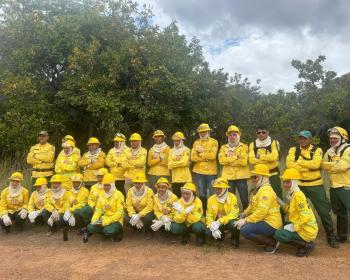The area between the Colonia (or Cachoeira) and Pardo rivers, in the municipalities of Itajú do Colônia, Pau-Brasil and Camaca, has been occupied by the Pataxó-Hahahai and Baena Indians from the time of the earliest records of the region (1610) to the present.
The advance of the national society in this southern area of the state of Bahia led to continual reductions in the area inhabited by Indians, until at the beginning of this century they were concentrated in the region of the present reservation of Caramuru-Paraguaçu. This reservation, the largest concentration of Indians in conditions isolated in the State, was created in 1926.
In 1936 the ranchers and landowners of the region began to take over Indian lands. The area of the reservation was reduced accordingly.
The ethnologist Curt Nimuendajú, in 1938, arranged the transfer of survivors of other indigenous groups to the reservation. Small groups of Botocudo, Kamaka, Tupiniquim, Menian and Kiriri-Sapuyá were moved to the reserve. These groups were located at the Paraguaçu Indian Post, while the Pataxó-Hahahai and Baena were located at the Caramuru Indian Post in the north of the reserve.
In accordance with the Indian policy of the period, the Indian Protection Service leased reservation timber and agricultural lands to non-Indians. Leases expressly forbade the installation of permanent improvements by the contractors.
These leases were designed to yield an income sufficient to defray the expenses of the assistance being rendered to the Indians. In fact, they permitted a virtual invasion of the reservation by the ranchers. Not satisfied, ranchers, on a number of occasions, attempted to have the State of Bahia seize the lands and expel the Indians. These efforts, however, were unsuccessful.
The loss of control over reservation lands forced many of the Indians to abandon the reservation and take refuge on other Indian Posts. Some nevertheless remained in the area, subsisting as paid laborers for the ranchers or salaried workers in private or public enterprises. The area was never completely abandoned by its legitimate owners.
The National Indian Foundation (FUNAI, the successor of the SPI after 1967) deactivated the Post in 1972, and from that time ceased to charge rents to the leaseholders. In 1976, the ranchers once again demanded that the land be turned over to them. FUNAI resolved to survey and demarcate the Indian lands once again in order to guarantee the survival of the Indians living on them. However, the state government of Bahia illegally distributed land titles to the ranchers. These ranchers effectively blocked FUNAI's attempts to survey the land.
In 1982, the Indians from the reservation who had been living as refugees on the Guaraní Ranch in the neighboring State of Minas Gerais decided to return to their own lands. FUNAI sought the protection of the Federal Police and accompanied the Indians when they reoccupied the ranch of Sao Lucas, a "property" entirely inside Indian lands. From that time on, authorities directly or indirectly concerned with the problem have been pressured to evict the Indians. FUNAI, having exhausted all possibilities of a negotiated solution, finally brought a suit in federal court.
Various sites were considered for the relocation of the Indians. All of these were remote and inaccessible areas without the minimal resources needed for subsistence. The governor of the state alleged that if the Indians were not removed, the government party would lose the election (12/82) because of the opposition of the ranchers. Unable to resist these pressures, FUNAI removed part of the Indian population of Sao Lucas to the Experimental Station of Almada, an area of 108 hectares (1 hectare = 2.49 acres). Part of the Indian population, however, remained on the ranch. State officials and opponents of the Indians cut off food supplies, suspended medical assistance and credit, and removed Federal Police protection, rendering them vulnerable to attacks by the ranchers.
In November 1982, the Indians who had remained at Sao Lucas brought suit in court, demanding a restraining order against the decision to relocate them. A federal judge issued a show-cause order restraining further transferences and ordering the return of the transferred Indians to their lands. Indians at Almada immediately prepared to return to Sao Lucas. The government of the State of Bahia, however, had the judge's order set aside. This was not immediately communicated to the Indians.
The death of an Indian child, and the decision to bury her in the ancestral territory, touched off the following chain of events. The Indians, not having been informed of the reversal of the decision allowing them to return, decided that they would all return to Sao Lucas. A group of armed ranchers prepared to meet and kill them upon arrival. They were, however, unsuccessful.
FUNAI applied in federal court for an order interdicting the area of the Sao Lucas Ranch where the Indians would then remain until a decision was reached regarding the land. The judge, lacking sufficient data, decided to inspect the area. Accompanied by interested parties and by an anthropologist, the judicial party was received by more than 500 armed men, who threatened and attempted to pressure the investigatory commission.
FUNAI is again under enormous pressure to remove the Indians from the ranch of Sao Lucas. The armed ranchers are threatening to invade the area where the Indians have taken refuge. The situation is critical, and the lives of the Indians are in danger. FUNAI may not resist pressures and may try to remove the Indians by force. Under present conditions this could precipitate a massacre.
Decision on FUNAI's case in federal court was deferred by the judge until February 8, 1983. In the meantime, the judge has ordered that the Indians be protected by the Federal Police. The Ministry of the Interior and the government of the State of Bahia are attempting to negotiate a settlement of the problem, based on a drastic reduction of the Indian area.
Article copyright Cultural Survival, Inc.



